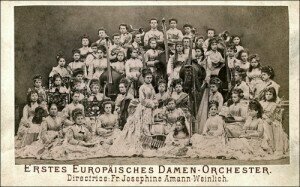
Wienlich’s Women’s Orchestra
There had been women’s orchestras in New York and Boston from the early 1870s, including such groups as the Vienna Damen Orchester, the Berlin Lady Orchestra, Marie Roller’s “Elite Kapelle,” the Ladies’ Philharmony, and The Women’s String Orchestra of New York, to name just a few, usually associated with local theatres.
Vienna also had its women’s orchestra, formed by Josephine Weinlich and growing from string quartet to septet to small ensemble until by 1871, they had 22 players. After their Russia tour, critics asked for more brass and the orchestra added 7 men – so the women’s orchestra became integrated.
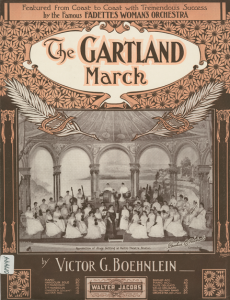
The Fadette Orchestra on the cover of The Gartland March
English composer Mary Wurm, formerly a student of Clara Schumann, founded and led a women’s orchestra in Berlin in 1898. Before that, she had been the first female conductor of the Berlin Philharmonic, in 1887.
Critics at the time thought that all women’s orchestras should confine themselves solely to light repertoire, and be used when an orchestra was needed for a social engagement. Long travel to engagement and long rehearsals were unthinkable. Women, on the other hand, argued that they had spent their time and money on professional training, but all the jobs went to men. The traditional women’s instruments of piano, harp, and guitar (because they were appropriate for home entertainment and did not involve facials exertions or body movements that interfered with the portrait of grace that a woman was supped to emanate), were augmented by women learning the violin, and brass, wind, and percussion instruments, as well as all the other instruments in the orchestra.
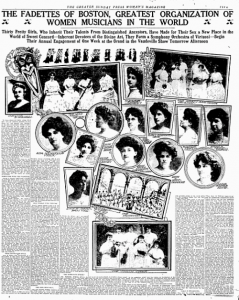
Fadettes in a Pittsburgh, PA, newspaper in 1909
Women began to be admitted to men’s orchestras starting in 1919 (Queen’s Hall Orchestra of London) but it was WWII that changed the situation for women. The absence of men to the war front opened chairs in the orchestras at home and women were increasingly able to keep those positions. One symphony administrator admitted that the addition of women to his orchestra meant an improvement in the generally raucous nature of the formerly all-male groups. Women’s orchestras began to be disbanded as opportunities to play in more prominent ensembles started to rob them of their players.
The oldest women’s orchestra in the world is the Cleveland Women’s Orchestra, founded in 1935 and still playing today. In all that time, they have had only two conductors: Hyman Schandler (then 2nd violinist in the Cleveland Orchestra), and 55 years later, Robert Cronquist.
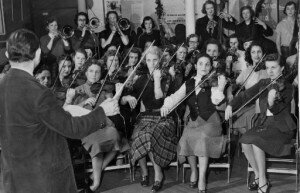
Cleveland Women’s Orchestra in their early days


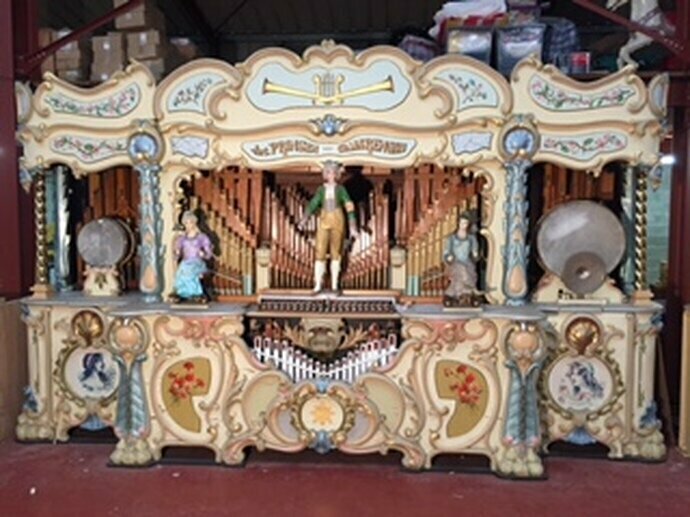




A note about a “fact” you state that either needs clarification, or is incorrect. Though I do not know the oldest women’s symphony orchestra, I do know that the Chicago Women’s Symphony Orchestra was founded in 1925, so before Cleveland’s. However, if you meant to say that Cleveland is the oldest women’s orchestra still running, that may be true, but your sentence needs clarification.
Yes, your comment is correct. Cleveland is the oldest still running.
Thank you.
I am a violinist in the Cleveland Women’s Orchestra – a member for many years and the manager
What a nice surprise to come across this article
Our second Music Director, Robert Cronquist passed away in 2018. The orchestra currently is conducted by Principal Conductor, John Thomas Dodson
We will celebrate our 85th Anniversary at our annual Severance Hall concert on April 5, 2020
Joan
My mom played violin in the orchestra during the 50s. Do you have any photos from that era?
Thanks for your time!
Hi Lynn,
I’m sorry – I’m just seeing this now.
I do have a photo from 1960.
What was your mother’s name at that time?
I would like whatever info you could give me about her tenure and memories from her etc.
I have the archives and hopefully – am writing a book